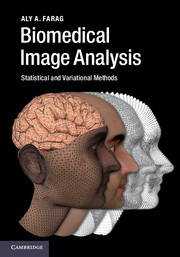Book contents
- Frontmatter
- Dedication
- Contents
- Preface
- Nomenclature
- 1 Overview of biomedical image analysis
- Part I Signals and systems, image formation, and image modality
- Part II Stochastic models
- Part III Computational geometry
- Part IV Variational approaches and level sets
- Part V Image analysis tools
- 11 Segmentation: statistical approach
- 12 Segmentation: variational approach
- 13 Basics of registration
- 14 Variational methods for shape registration
- 15 Statistical models of shape and appearance
- Index
- References
12 - Segmentation: variational approach
from Part V - Image analysis tools
Published online by Cambridge University Press: 05 November 2014
- Frontmatter
- Dedication
- Contents
- Preface
- Nomenclature
- 1 Overview of biomedical image analysis
- Part I Signals and systems, image formation, and image modality
- Part II Stochastic models
- Part III Computational geometry
- Part IV Variational approaches and level sets
- Part V Image analysis tools
- 11 Segmentation: statistical approach
- 12 Segmentation: variational approach
- 13 Basics of registration
- 14 Variational methods for shape registration
- 15 Statistical models of shape and appearance
- Index
- References
Summary
Introduction
This chapter deals with image segmentation using the variational and level-set methods discussed in Chapter 10. Over three decades of work in the literature (1960–1990) has been devoted to gradient-based and statistical-based approaches for detection and linking of objects’ boundaries. These approaches have a mixed record of success owing to the ill-posed nature of the problem, and they do not easily adapt to fusion of a priori information about the objects or the imaging sensors. Variational approaches provide an alternative view to purely gradient-based and statistical-based methods. These approaches extract the object boundaries through an energy minimization framework that controls the propagation of a parametric curve or surface (sometimes called a front, as indicated in Chapter 10) inside the objects of interest. Two techniques have been proposed for controlling the curve propagation: active contours (snakes), introduced by Kass, Witkin and Terzopoulos in 1987 [12.1] (see also 12.2],[12.3]), and the level-sets approach, introduced by Osher and Sethian in 1988 [12.4]. At the heart of the active contours and the level-set approaches is an energy formulation that implicitly describes the curve/surface propagation in terms of a set of partial differential equations that can be solved numerically to determine the steady state position of the front. The level-set methods (LSM) have proven to be more efficient and flexible than active contours; the image segmentation algorithms developed in this chapter will be mainly based on the LSM.
As stated in the previous chapter, image segmentation deals with separating objects using the intrinsic information in the image (its intensity statistics, edge information, and other salient characteristics) and whatever known (a priori) shape information is available about the objects in the image (e.g. the kidney shape in the medical images in Figure 12.1). Other than providing a comprehensive survey and comparison of methods, this chapter will augment the theoretical foundation of the curve/surface modeling and propagation covered in Chapter 10 as applied to the segmentation problem.
Information
- Type
- Chapter
- Information
- Biomedical Image AnalysisStatistical and Variational Methods, pp. 316 - 344Publisher: Cambridge University PressPrint publication year: 2014
